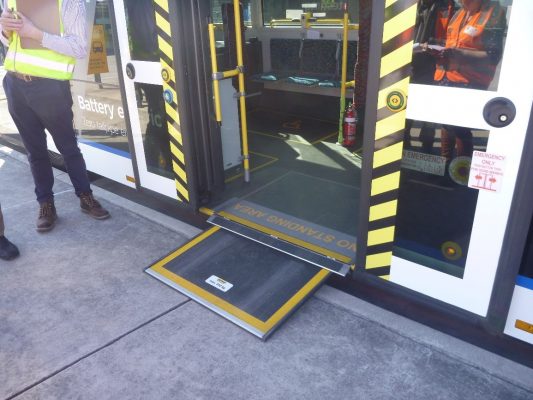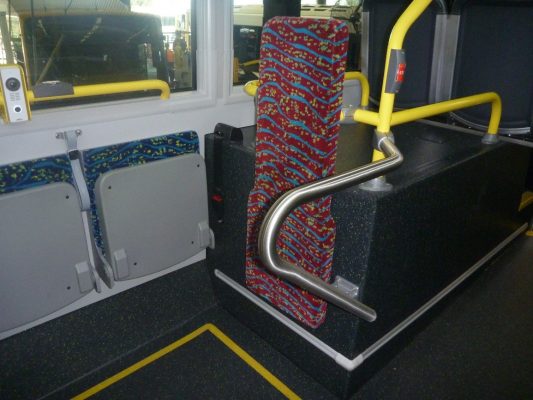Objective: Meeting the functional compliance outcomes of the Disability Standards for Accessible Public Transport 2002 (DSAPT)
Architecture & Access is currently involved in the Brisbane Metro Vehicle project (engaged by Brisbane City Council)
As part of the assessment in achieving compliance with the DSAPT, the Brisbane Metro project has conducted extensive consultation involving a series of interactive sessions with the Brisbane Metro Accessibility Working Group (BM-AWG), as well as independent research conducted by Federation University in Victoria, regarding circulation and manoeuvrability of mobility devices. These interactive sessions began with a taped-out mock-up of the first section of the vehicle where the allocated spaces are located and then progressed to a full-size mock-up in February 2021.
In June this year, Architecture & Access, working with Federation University, conducted further testing of the newly arrived fully functional pilot vehicle.
Of the six participants who tested the mock-up BMV in 2021 only three participants were not able to continue, so new volunteers were recruited for the 2022 pilot BMV trial. We particularly sought to have representation from people using manual wheelchairs in the 2022 test and included these new members, for a total of seven participants.
Participants in the 2022 trial included two using powered mobility for all ambulation replacement, three using manual wheelchairs (with opportunity for power assist), and two participants who used scooters able to transfer out of their powered mobility device and ambulate short distances.
Key Areas Assessed by Participants
Automatic Ramp (DSAPT Part 6 and Part 8)

The ramp will deploy automatically, either when a button is pressed or when the Metro arrives at the platform. The ramp and doors will be operated by the driver. Prior to the deployment of the ramp, the vehicle will kneel or lower to ensure the shallowest possible gradient is achieved upon entering. On the whole, access into the vehicle via the ramp was well received and further enhancement to the ramp messaging on deployment and smooth transition at the threshold are being investigated.
Safety in Transit (DSAPT Part 9.11)
“An allocated space must contain movement of a mobility aid towards the front or sides of a conveyance”.
Different types of methods for passive and active restraint were assessed as part of the research.
Types of Restraints
- Forward Excursion Barrier (ironing board) (FEB), and Lateral Excursion Barrier (LEB)
- Tether / Hand hold strap. A strap system (made of webbing) that has a loop on the end that is mounted on the bus wall or on a horizontal rail, that a passenger may hold onto.
- WTORS Passive – Wheelchair Tie down and Occupant Restraint System- Passive (WTORS Passive), where there is no need for the mobility device user or another person to manually affix strapping of any kind. For example, relies on person positioning mobility device against a padded backboard, with lateral stanchion support.
- Wheelchair Tie down and Occupant Restraint System – Active (WTORS Active), where there is a need for the mobility device user or another person to manually affix some form of strapping or tie down system between the wheelchair and the bus.
- Restraint systems may take 3 forms:
- Bus seatbelt (person to mobility device to bus- Active WTORS)
- Mobility device restraint (mobility device to bus – Active WTORS)
- Mobility device seatbelt (person to mobility device-this is a personal restraint and not a WTORS)

Example of tether strap, seat belt and lateral restraint (grab bar)
The research confirmed compliance with the DSAPT Part 9.11 was achieved. Overall participants preferred the grab bar option (Photo 2) and the tether straps, which are available in each space. The importance of having multiple options was well received. Further design will progress these options, considering participant feedback on height, location and design.
Manoeuvring into and out of the allocated spaces (DSAPT Part 3.2)
“ (1) Passengers in wheelchairs or mobility aids must be able to enter and exit a conveyance and position their aids in the allocated space.”
The research confirmed compliance with the DSAPT Part 3.2 in that all participants were able to manoeuvre into each of the 3 spaces, in the preferred rearward position despite the introduction of a fixed lateral restraint indicated in the tether strap image. This was significantly supported by the large, clear floor spaces.
The testing undertaken with the pilot BMV demonstrated that the vehicle is performing very well for people using mobility devices in terms of access, manoeuvrability and the potential for safety features to limit slide and tip. However, the testing was undertaken with all participants in a stationary vehicle. The next steps to consider may include on road testing.
For updates of the Brisbane Metro Vehicle see link:
https://www.brisbane.qld.gov.au/traffic-and-transport/public-transport/brisbane-metro/the-metro
Reference: Unsworth, C.A. & Flores, P. (2022). Testing of mobility device access spaces with passive containment system on Brisbane Metro vehicles: Research Report 4: Pilot Trial Findings and recommendations. Brisbane City Council Qld.
Main image: The research team, Allison Crunden, Patricia Flores from Architecture & Access and Professor Carolyn Unsworth, Federation University